Bioclimatic Zoning and Climate Change Impacts on Dairy Cattle in Maranhão, Brazil
Simple Summary
Abstract
1. Introduction
2. Materials and Methods
2.1. Characterization of the Study Area
2.2. Data Collection and Processing
2.3. Data Analysis
3. Results and Discussion
3.1. Historical Scenario
3.2. Future Scenarios (RCP 4.5 and 8.5)
4. Conclusions
Supplementary Materials
Author Contributions
Funding
Institutional Review Board Statement
Informed Consent Statement
Data Availability Statement
Acknowledgments
Conflicts of Interest
References
- Bonthuys, J. Global Risk of Heat Stress on Cattle. Nat. Afr. 2023. Available online: https://www.nature.com/articles/d44148-023-00244-7 (accessed on 12 February 2025). [CrossRef]
- Broom, D.M. Animal Welfare Complementing or Conflicting with Other Sustainability Issues. Appl. Anim. Behav. Sci. 2019, 219, 104829. [Google Scholar] [CrossRef]
- Rahimi, J.; Fillol, E.; Mutua, J.Y.; Cinardi, G.; Robinson, T.P.; Notenbaert, A.M.O.; Ericksen, P.J.; Graham, M.W.; Butterbach-Bahl, K. A Shift from Cattle to Camel and Goat Farming Can Sustain Milk Production with Lower Inputs and Emissions in North Sub-Saharan Africa’s Drylands. Nat. Food 2022, 3, 523–531. [Google Scholar] [CrossRef] [PubMed]
- Burhans, W.S.; Rossiter Burhans, C.A.; Baumgard, L.H. Invited Review: Lethal Heat Stress: The Putative Pathophysiology of a Deadly Disorder in Dairy Cattle. J. Dairy Sci. 2022, 105, 3716–3735. [Google Scholar] [CrossRef] [PubMed]
- Polsky, L.; Von Keyserlingk, M.A.G. Invited Review: Effects of Heat Stress on Dairy Cattle Welfare. J. Dairy Sci. 2017, 100, 8645–8657. [Google Scholar] [CrossRef] [PubMed]
- Sejian, V.; Bhatta, R.; Gaughan, J.B.; Dunshea, F.R.; Lacetera, N. Review: Adaptation of Animals to Heat Stress. Animal 2018, 12, s431–s444. [Google Scholar] [CrossRef]
- Thornton, P.K. Livestock Production: Recent Trends, Future Prospects. Phil. Trans. R. Soc. B 2010, 365, 2853–2867. [Google Scholar] [CrossRef]
- St-Pierre, N.R.; Cobanov, B.; Schnitkey, G. Economic Losses from Heat Stress by US Livestock Industries. J. Dairy Sci. 2003, 86, E52–E77. [Google Scholar] [CrossRef]
- Thornton, P.; Nelson, G.; Mayberry, D.; Herrero, M. Impacts of Heat Stress on Global Cattle Production during the 21st Century: A Modelling Study. Lancet Planet. Health 2022, 6, e192–e201. [Google Scholar] [CrossRef]
- Sejian, V.; Shashank, C.G.; Silpa, M.V.; Madhusoodan, A.P.; Devaraj, C.; Koenig, S. Non-Invasive Methods of Quantifying Heat Stress Response in Farm Animals with Special Reference to Dairy Cattle. Atmosphere 2022, 13, 1642. [Google Scholar] [CrossRef]
- Hoffmann, G.; Herbut, P.; Pinto, S.; Heinicke, J.; Kuhla, B.; Amon, T. Animal-Related, Non-Invasive Indicators for Determining Heat Stress in Dairy Cows. Biosyst. Eng. 2020, 199, 83–96. [Google Scholar] [CrossRef]
- Felini, R.; Cavallini, D.; Buonaiuto, G.; Bordin, T. Assessing the Impact of Thermoregulatory Mineral Supplementation on Thermal Comfort in Lactating Holstein Cows. Vet. Anim. Sci. 2024, 24, 100363. [Google Scholar] [CrossRef]
- Nzeyimana, J.B.; Fan, C.; Zhuo, Z.; Butore, J.; Cheng, J. Heat Stress Effects on the Lactation Performance, Reproduction, and Alleviating Nutritional Strategies in Dairy Cattle, a Review. J. Anim. Behav. Biometeorol. 2023, 11, 2023018. [Google Scholar] [CrossRef]
- Giannone, C.; Bovo, M.; Ceccarelli, M.; Torreggiani, D.; Tassinari, P. Review of the Heat Stress-Induced Responses in Dairy Cattle. Animals 2023, 13, 3451. [Google Scholar] [CrossRef]
- Becker, C.A.; Collier, R.J.; Stone, A.E. Invited Review: Physiological and Behavioral Effects of Heat Stress in Dairy Cows. J. Dairy Sci. 2020, 103, 6751–6770. [Google Scholar] [CrossRef] [PubMed]
- Pinto, S.; Hoffmann, G.; Ammon, C.; Amon, T. Critical THI Thresholds Based on the Physiological Parameters of Lactating Dairy Cows. J. Therm. Biol. 2020, 88, 102523. [Google Scholar] [CrossRef] [PubMed]
- De Castro Júnior, S.L.; Silva, I.J.O.D. The Specific Enthalpy of Air as an Indicator of Heat Stress in Livestock Animals. Int. J. Biometeorol. 2021, 65, 149–161. [Google Scholar] [CrossRef]
- Tempel Stumpf, M.; Jacob Kolling, G.; Fischer, V.; Dos Santos Daltro, D.; Priscila Munchen Alfonzo, E.; Calderaro Dalcin, V.; Talarico Dias, L.; Vinicius Gualberto Barbosa Da Silva, M.; Peripolli, V.; Margaret McManus, C. Elevated Temperature-Humidity Index Induces Physiological, Blood and Milk Alterations in Holstein Cows in a More Pronounced Manner than in ½ and ¾ Holstein × Gir. J. Anim. Behav. Biometeorol. 2021, 9, 2140. [Google Scholar] [CrossRef]
- Aparecido, L.E.D.O.; Lorençone, J.A.; Lorençone, P.A.; Torsoni, G.B.; De Moraes, J.R.D.S.C.; De Meneses, K.C. Bioclimatic Zoning for Dairy Cows in Brazil by Statistical Modeling. J. Sci. Food Agric. 2022, 102, 3847–3857. [Google Scholar] [CrossRef]
- Marinho, G.T.B.; Pandorfi, H.; Da Silva, M.V.; Montenegro, A.A.D.A.; De Sousa, L.D.B.; Desenzi, R.; Da Silva, J.L.B.; De Oliveira-Júnior, J.F.; Mesquita, M.; De Almeida, G.L.P.; et al. Bioclimatic Zoning for Sheep Farming through Geostatistical Modeling in the State of Pernambuco, Brazil. Animals 2023, 13, 1124. [Google Scholar] [CrossRef]
- Turco, S.H.N.; Silva, T.G.F.D.; Santos, L.F.C.D.; Ribeiro, P.H.B.; Araújo, G.G.L.D.; Holanda Junior, E.V.; Aguiar, M.A. Zoneamento Bioclimático Para Vacas Leiteiras No Estado Da Bahia. Eng. Agríc. 2006, 26, 20–27. [Google Scholar] [CrossRef]
- Ferreira, N.C.R.; Andrade, R.R.; Ferreira, L.N. Climate Change Impacts on Livestock in Brazil. Int. J. Biometeorol. 2024, 68, 2693–2704. [Google Scholar] [CrossRef]
- Gebrechorkos, S.H.; Taye, M.T.; Birhanu, B.; Solomon, D.; Demissie, T. Future Changes in Climate and Hydroclimate Extremes in East Africa. Earth’s Future 2023, 11, e2022EF003011. [Google Scholar] [CrossRef]
- Al Qudah, A.; Rusan, M.J.; Al-Qinna, M.I.; Abdulla, F.A. Climate Change Vulnerability Assessment for Selected Agricultural Responses at Yarmouk River Basin Area, Jordan. Mitig. Adapt. Strat. Glob. Change 2021, 26, 3. [Google Scholar] [CrossRef]
- Arnell, N.W.; Freeman, A. The Effect of Climate Change on Agro-Climatic Indicators in the UK. Clim. Change 2021, 165, 40. [Google Scholar] [CrossRef]
- Ayugi, B.O.; Chung, E.-S.; Zhu, H.; Ogega, O.M.; Babousmail, H.; Ongoma, V. Projected Changes in Extreme Climate Events over Africa under 1.5 °C, 2.0 °C and 3.0 °C Global Warming Levels Based on CMIP6 Projections. Atmos. Res. 2023, 292, 106872. [Google Scholar] [CrossRef]
- Thornton, P.; Nelson, G.; Mayberry, D.; Herrero, M. Increases in Extreme Heat Stress in Domesticated Livestock Species during the Twenty-first Century. Glob. Change Biol. 2021, 27, 5762–5772. [Google Scholar] [CrossRef]
- Bhunia, G.S.; Shit, P.K.; Maiti, R. Comparison of GIS-Based Interpolation Methods for Spatial Distribution of Soil Organic Carbon (SOC). J. Saudi Soc. Agric. Sci. 2018, 17, 114–126. [Google Scholar] [CrossRef]
- Silva, A.A.; Lacerda, J.J.D.J.; De Araújo-Neto, R.B.; Sagrilo, E.; Lustosa-Filho, J.F.; Andrade, H.A.F.D.; De Souza, H.A. Integrated Agroforestry System Affects the Dynamics of Inorganic Phosphorus Fractions in the Savanna of Brazilian Northeast. Can. J. Soil. Sci. 2024, 104, 181–190. [Google Scholar] [CrossRef]
- Conceição, A.O.; Andrade, H.A.F.D.; Rego, C.A.R.D.M.; Morais, P.A.D.O.; Pereira, R.Y.F.; Sousa, A.M.D.; Santos, G.A.D.A.; Moraes, L.F.; Machado, N.A.F.; Silva-Matos, R.R.S.D. New Organic Substrates for Seedling Production in the Transition Zone between the Amazon-Cerrado Biomes. Rev. Bras. Eng. Agríc. Ambient. 2024, 28, e279358. [Google Scholar] [CrossRef]
- Silva, Z.F.D.; Andrade, A.C.; Bento Junior, F.D.A.; Sousa, R.S.; Loiola, J.M.L. Características Do Sistema de Produção de Leite Da Microrregião de Imperatriz, No Estado Do Maranhão. RCA 2012, 55, 44–49. [Google Scholar] [CrossRef]
- IBGE. Cidades; IBGE-Instituto Brasileiro de Geografia e Estatística: Rio de Janeiro, Brazil, 2023.
- Valverde, M.C.; Marengo, J.A. Extreme Rainfall Indices in the Hydrographic Basins of Brazil. Open J. Mod. Hydrol. 2014, 4, 10–26. [Google Scholar] [CrossRef]
- Vommaro, F.; Menezes, J.A.; Barata, M.M.D.L. Contributions of Municipal Vulnerability Map of the Population of the State of Maranhão (Brazil) to the Sustainable Development Goals. Sci. Total. Environ. 2020, 706, 134629. [Google Scholar] [CrossRef]
- Alvares, C.A.; Stape, J.L.; Sentelhas, P.C.; De Moraes Gonçalves, J.L. Modeling Monthly Mean Air Temperature for Brazil. Theor. Appl. Clim. 2013, 113, 407–427. [Google Scholar] [CrossRef]
- Beck, H.E.; McVicar, T.R.; Vergopolan, N.; Berg, A.; Lutsko, N.J.; Dufour, A.; Zeng, Z.; Jiang, X.; Van Dijk, A.I.J.M.; Miralles, D.G. High-Resolution (1 Km) Köppen-Geiger Maps for 1901–2099 Based on Constrained CMIP6 Projections. Sci. Data 2023, 10, 724. [Google Scholar] [CrossRef]
- Abatzoglou, J.T.; Dobrowski, S.Z.; Parks, S.A.; Hegewisch, K.C. TerraClimate, a High-Resolution Global Dataset of Monthly Climate and Climatic Water Balance from 1958–2015. Sci. Data 2018, 5, 170191. [Google Scholar] [CrossRef]
- Araújo, M.L.S.D.; Rufino, I.A.A.; Silva, F.B.; Brito, H.C.D.; Santos, J.R.N. The Relationship between Climate, Agriculture and Land Cover in Matopiba, Brazil (1985–2020). Sustainability 2024, 16, 2670. [Google Scholar] [CrossRef]
- Silva, M.V.D.; Pandorfi, H.; Almeida, G.L.P.D.; Jardim, A.M.D.R.F.; Batista, P.H.D.; Silva, R.A.B.D.; Lopes, I.; Oliveira, M.E.G.D.; Silva, J.L.B.D.; Moraes, A.S. Spatial Variability and Exploratory Inference of Abiotic Factors in Barn Compost Confinement for Cattle in the Semiarid. J. Therm. Biol. 2020, 94, 102782. [Google Scholar] [CrossRef] [PubMed]
- Berry, I.L.; Shanklin, M.D.; Johnson, H.D. Dairy Shelter Design Based on Milk Production Decline as Affected by Temperature and Humidity. Trans. ASAE 1964, 7, 329–331. [Google Scholar] [CrossRef]
- Mader, T.L.; Davis, M.S.; Brown-Brandl, T. Environmental Factors Influencing Heat Stress in Feedlot Cattle1,2. J. Anim. Sci. 2006, 84, 712–719. [Google Scholar] [CrossRef]
- Fuquay, J.W. Heat Stress as It Affects Animal Production. J. Anim. Sci. 1981, 52, 164–174. [Google Scholar] [CrossRef]
- Evin, G.; Hingray, B.; Blanchet, J.; Eckert, N.; Morin, S.; Verfaillie, D. Partitioning Uncertainty Components of an Incomplete Ensemble of Climate Projections Using Data Augmentation. J. Clim. 2019, 32, 2423–2440. [Google Scholar] [CrossRef]
- Lyra, G.B.; Correia, T.P.; De Oliveira-Júnior, J.F.; Zeri, M. Evaluation of Methods of Spatial Interpolation for Monthly Rainfall Data over the State of Rio de Janeiro, Brazil. Theor. Appl. Clim. 2018, 134, 955–965. [Google Scholar] [CrossRef]
- McPherson, R.A. Monitoring the Drought of 1998 in the Southern Plains. Bull. Am. Meteorol. Soc. 1999, 80, 429–438. [Google Scholar] [CrossRef]
- Tsesmelis, D.E.; Leveidioti, I.; Karavitis, C.A.; Kalogeropoulos, K.; Vasilakou, C.G.; Tsatsaris, A.; Zervas, E. Spatiotemporal Application of the Standardized Precipitation Index (SPI) in the Eastern Mediterranean. Climate 2023, 11, 95. [Google Scholar] [CrossRef]
- McKee, T.B.; Doesken, N.J.; Kleist, J. The relationship of drought frequency and duration to time scales. In Proceedings of the 8th Conference on Applied Climatology, Anaheim, CA, USA, 17 January 1993; American Meteorological Society: Boston, MA, USA, 1993; Volume 17, pp. 179–183. [Google Scholar]
- Hohn, M.E. An Introduction to Applied Geostatistics. Comput. Geosci. 1991, 17, 471–473. [Google Scholar] [CrossRef]
- Johnston, K.; Hoef, J.M.V.; Krivoruchko, K.; Lucas, N. Using ArcGIS Geostatistical Analysis; GIS User Manual by ESRI; ESRI Press: Redlands, CA, USA, 2011. [Google Scholar]
- Cambardella, C.A.; Moorman, T.B.; Novak, J.M.; Parkin, T.B.; Karlen, D.L.; Turco, R.F.; Konopka, A.E. Field-Scale Variability of Soil Properties in Central Iowa Soils. Soil. Sci. Soc. Am. J. 1994, 58, 1501–1511. [Google Scholar] [CrossRef]
- Warrick, A.W.; Nielsen, D.R. Spatial Variability of Soil Physical Properties in the Field. In Applications of Soil Physics; Elsevier: Amsterdam, The Netherlands, 1980; pp. 319–344. ISBN 978-0-12-348580-9. [Google Scholar]
- Goovaerts, P. Geostatistics for Natural Resources Evaluation; Oxford University Press: Oxford, UK, 1997; ISBN 978-0-19-511538-3. [Google Scholar]
- Cerón, W.L.; Andreoli, R.V.; Kayano, M.T.; Canchala, T.; Carvajal-Escobar, Y.; Souza, R.A.F. Comparison of Spatial Interpolation Methods for Annual and Seasonal Rainfall in Two Hotspots of Biodiversity in South America. An. Acad. Bras. Ciênc. 2021, 93, e20190674. [Google Scholar] [CrossRef]
- Hengl, T.; Mendes De Jesus, J.; Heuvelink, G.B.M.; Ruiperez Gonzalez, M.; Kilibarda, M.; Blagotić, A.; Shangguan, W.; Wright, M.N.; Geng, X.; Bauer-Marschallinger, B.; et al. SoilGrids250m: Global Gridded Soil Information Based on Machine Learning. PLoS ONE 2017, 12, e0169748. [Google Scholar] [CrossRef]
- Carvalho, M.W.L.; Corrêa, W.C.; Teixeira, M.A.D.C.M.; Teixeira Cortez, C.; Silva, A.C.D. Variabilidade Pluviométrica e Índice de Anomalia de Chuvas Em Municípios Do Piauí. Geogr. Ensino Pesqui. 2023, 27, e71043. [Google Scholar] [CrossRef]
- De Medeiros, F.J.; De Oliveira, C.P. Dynamical Aspects of the Recent Strong El Niño Events and Its Climate Impacts in Northeast Brazil. Pure Appl. Geophys. 2021, 178, 2315–2332. [Google Scholar] [CrossRef]
- Santos, C.A.G.; Santos, D.C.D.; Brasil Neto, R.M.; De Oliveira, G.; Dos Santos, C.A.C.; Silva, R.M.D. Analyzing the Impact of Ocean-Atmosphere Teleconnections on Rainfall Variability in the Brazilian Legal Amazon via the Rainfall Anomaly Index (RAI). Atmos. Res. 2024, 307, 107483. [Google Scholar] [CrossRef]
- Silva, M.V.D.; Silva, J.L.B.D.; Ferreira, M.B.; Sousa, L.D.B.D.; Montenegro, A.A.D.A.; Isidoro, J.M.G.P.; Pandorfi, H.; Oliveira-Júnior, J.F.D.; Fernandez, H.M.N.P.V.; Granja-Martins, F.M.; et al. Geostatistical Modeling of the Rainfall Patterns and Monthly Multiscale Characterization of Drought in the South Coast of the Northeast Brazilian via Standardized Precipitation Index. Atmos. Res. 2024, 311, 107668. [Google Scholar] [CrossRef]
- Junqueira, R.; Viola, M.R.; De Mello, C.R.; Vieira-Filho, M.; Alves, M.V.G.; Amorim, J.D.S. Drought Severity Indexes for the Tocantins River Basin, Brazil. Theor. Appl. Clim. 2020, 141, 465–481. [Google Scholar] [CrossRef]
- De Oliveira, M.L.; Dos Santos, C.A.C.; De Oliveira, G.; Silva, M.T.; Da Silva, B.B.; Cunha, J.E.D.B.L.; Ruhoff, A.; Santos, C.A.G. Remote Sensing-Based Assessment of Land Degradation and Drought Impacts over Terrestrial Ecosystems in Northeastern Brazil. Sci. Total. Environ. 2022, 835, 155490. [Google Scholar] [CrossRef]
- De Sousa, W.G.; Silva, M.T.; Siqueira, M.D.S.; Gomes, H.B.; Oliveira, G.D.; Da Silva, T.G.F.; Cavalcanti, E.P. Variabilidade Espaço Temporal Da Seca Meteorológica Nas Microrregiões Do MATOPIBA. Rev. Bras. Geogr. Física 2024, 17, 1–21. [Google Scholar] [CrossRef]
- Aparecida De Souza Santos, J.; Wanderley, H.S.; Carlos De Amorim, R.F.; Delgado, R.C.; Fernades, R.C. The Longest Multiannual Drought in Northeastern Brazil. J. South. Am. Earth Sci. 2024, 143, 104976. [Google Scholar] [CrossRef]
- Lamanna, M.; Muca, E.; Buonaiuto, G.; Formigoni, A.; Cavallini, D. From Posts to Practice: Instagram’s Role in Veterinary Dairy Cow Nutrition Education—How Does the Audience Interact and Apply Knowledge? A Survey Study. J. Dairy Sci. 2025, 108, 1659–1671. [Google Scholar] [CrossRef]
- Rodrigues, R.C.; Tosta, X.M.; De Araújo, R.A.; Santos, F.N.D.S.; Silva, R.R.D.; De Oliveira, L.B.T.; Da Silva, I.R.; Cutrim Junior, J.A.A.; Lana, R.D.P.; Zanine, A.D.M.; et al. Grazing Behavior and Performance of Cattle Supplemented with Increasing Levels of Babassu Meal on Marandu-Grass Pastures in Silvopastoral Systems. Biol. Rhythm. Res. 2022, 53, 696–706. [Google Scholar] [CrossRef]
- Paiva, P.F.P.R.; De Lourdes Pinheiro Ruivo, M.; Da Silva Júnior, O.M.; De Nazaré Martins Maciel, M.; Braga, T.G.M.; De Andrade, M.M.N.; Dos Santos Junior, P.C.; Da Rocha, E.S.; De Freitas, T.P.M.; Da Silva Leite, T.V.; et al. Deforestation in Protect Areas in the Amazon: A Threat to Biodiversity. Biodivers. Conserv. 2020, 29, 19–38. [Google Scholar] [CrossRef]
- Rahimi, J.; Mutua, J.Y.; Notenbaert, A.M.O.; Marshall, K.; Butterbach-Bahl, K. Heat Stress Will Detrimentally Impact Future Livestock Production in East Africa. Nat. Food 2021, 2, 88–96. [Google Scholar] [CrossRef] [PubMed]
- Foroushani, S.; Amon, T. Thermodynamic Assessment of Heat Stress in Dairy Cattle: Lessons from Human Biometeorology. Int. J. Biometeorol. 2022, 66, 1811–1827. [Google Scholar] [CrossRef] [PubMed]
- Herbut, P.; Angrecka, S.; Walczak, J. Environmental Parameters to Assessing of Heat Stress in Dairy Cattle—A Review. Int. J. Biometeorol. 2018, 62, 2089–2097. [Google Scholar] [CrossRef] [PubMed]
- Oliveira, S.E.O.; De Melo Costa, C.C.; Chiquitelli Neto, M.; Dalla Costa, F.A.; Maia, A.S.C. Effects of Shade Location and Protection from Direct Solar Radiation on the Behavior of Holstein Cows. Int. J. Biometeorol. 2019, 63, 1465–1474. [Google Scholar] [CrossRef]
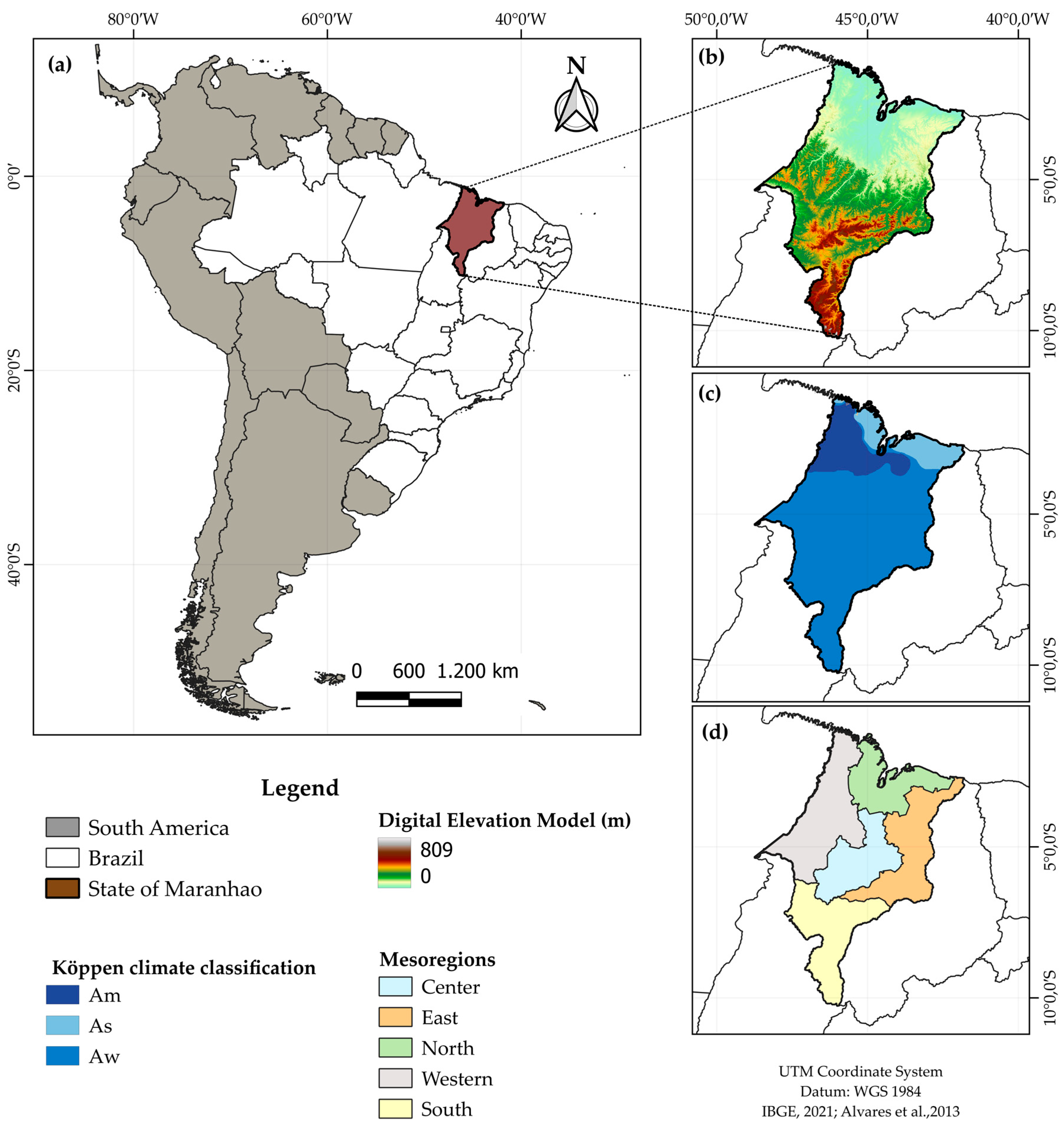
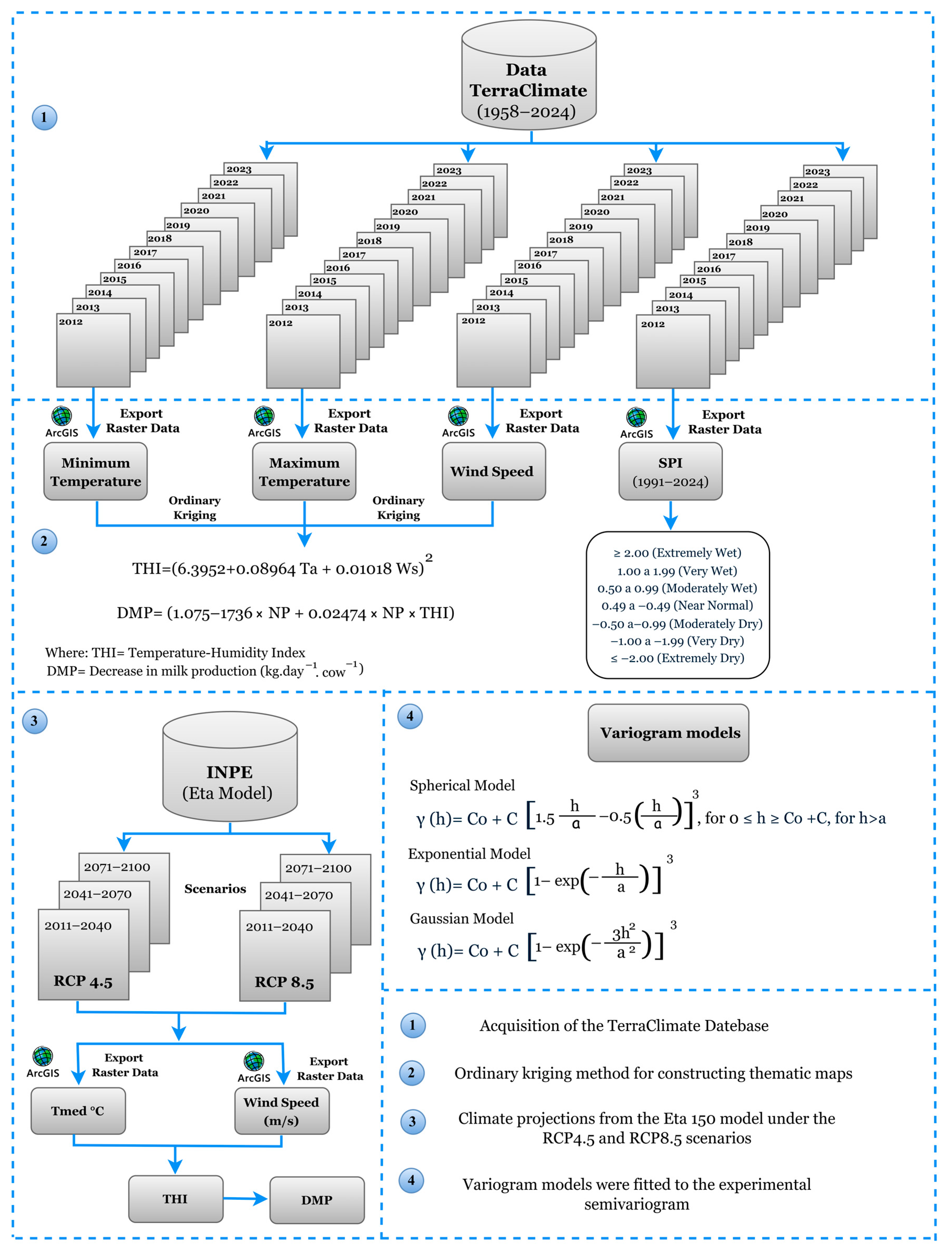

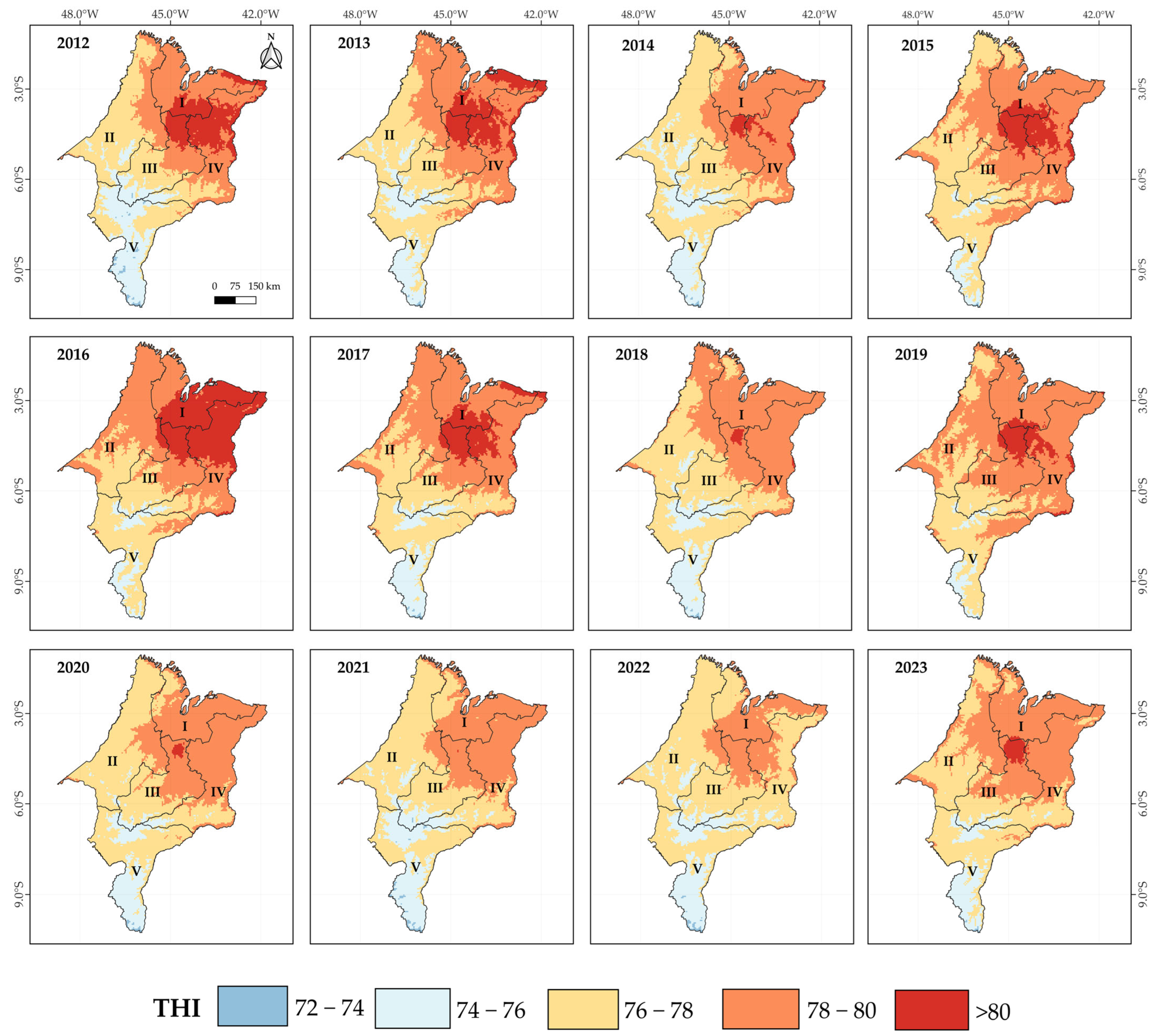


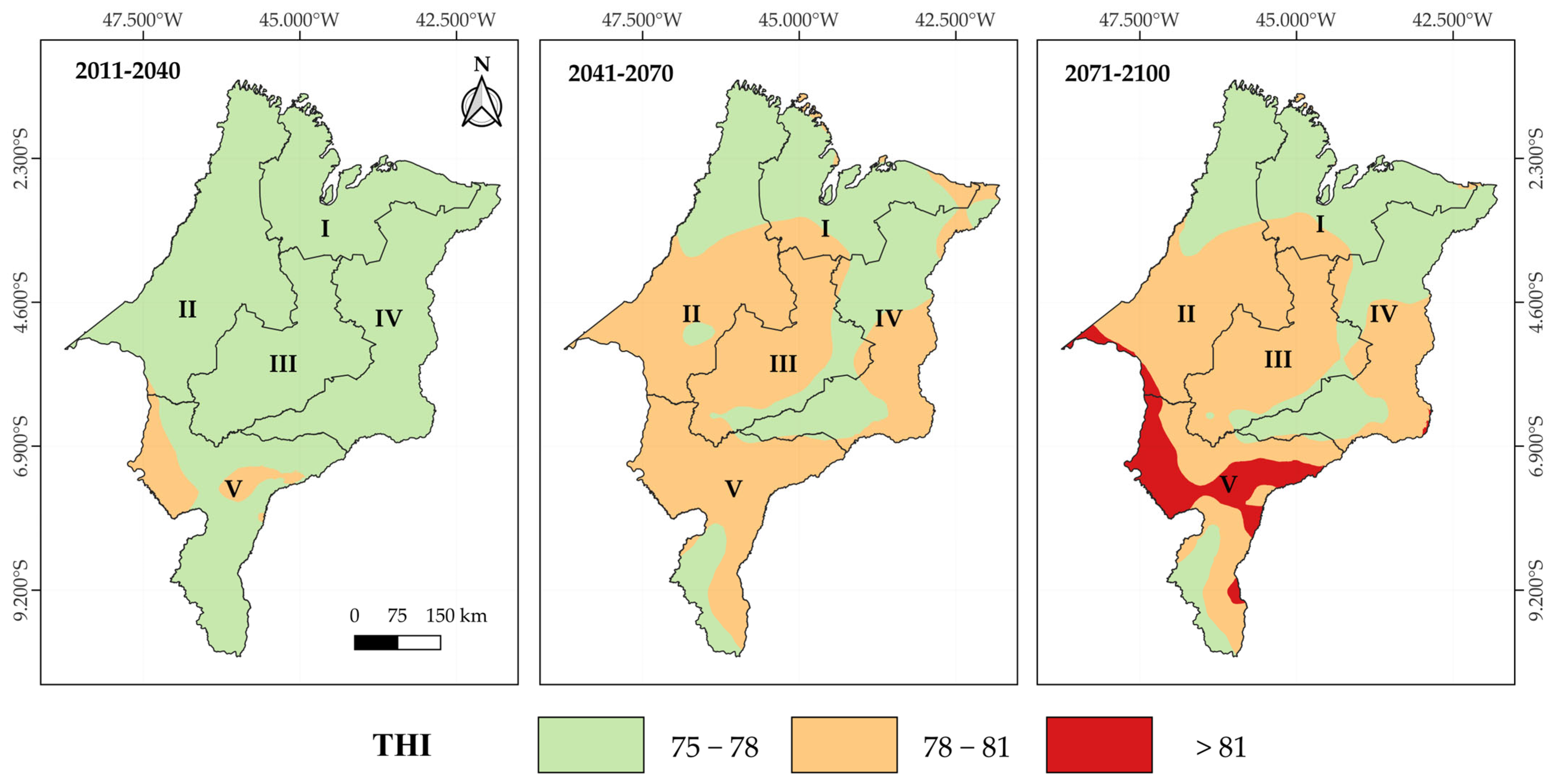
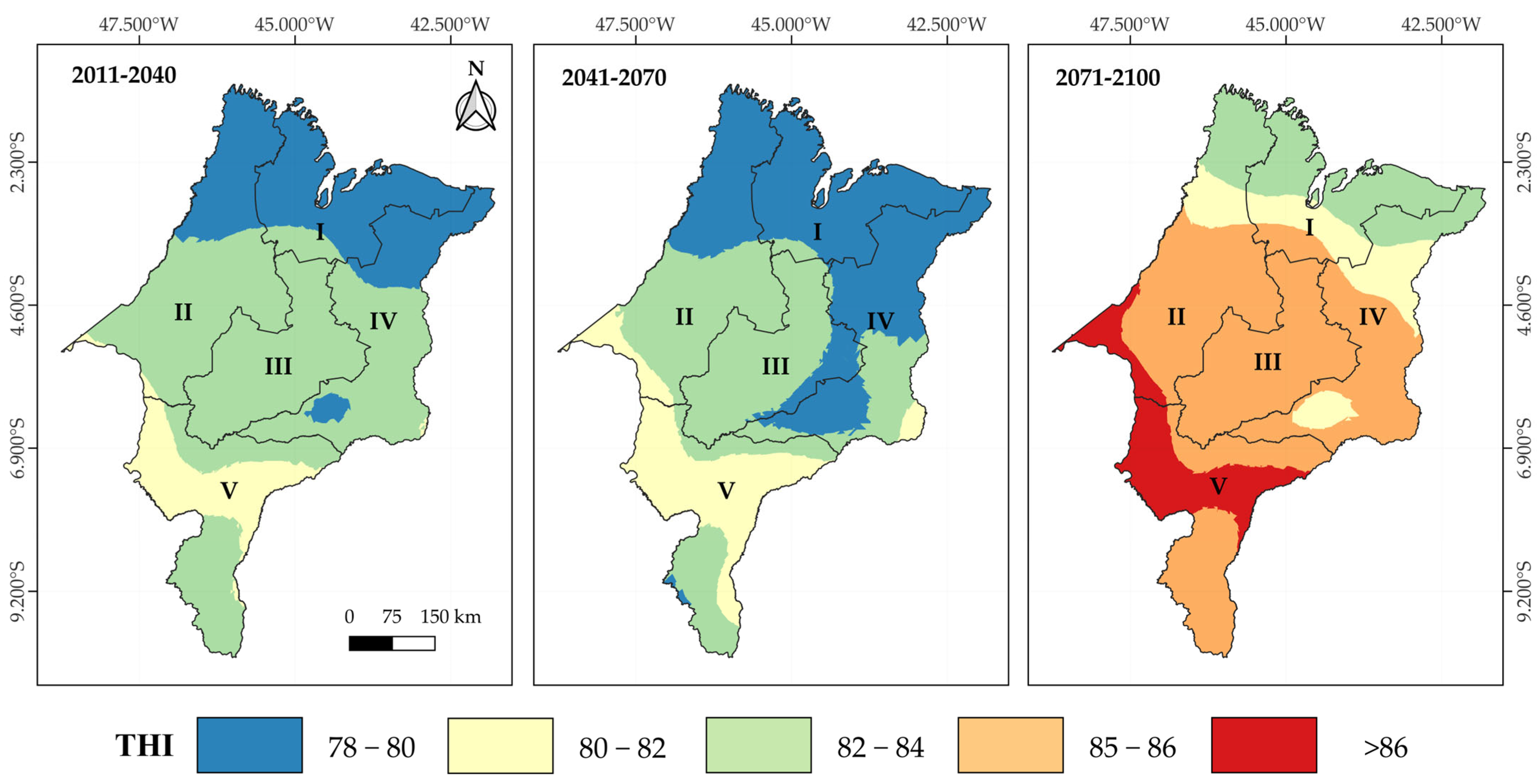
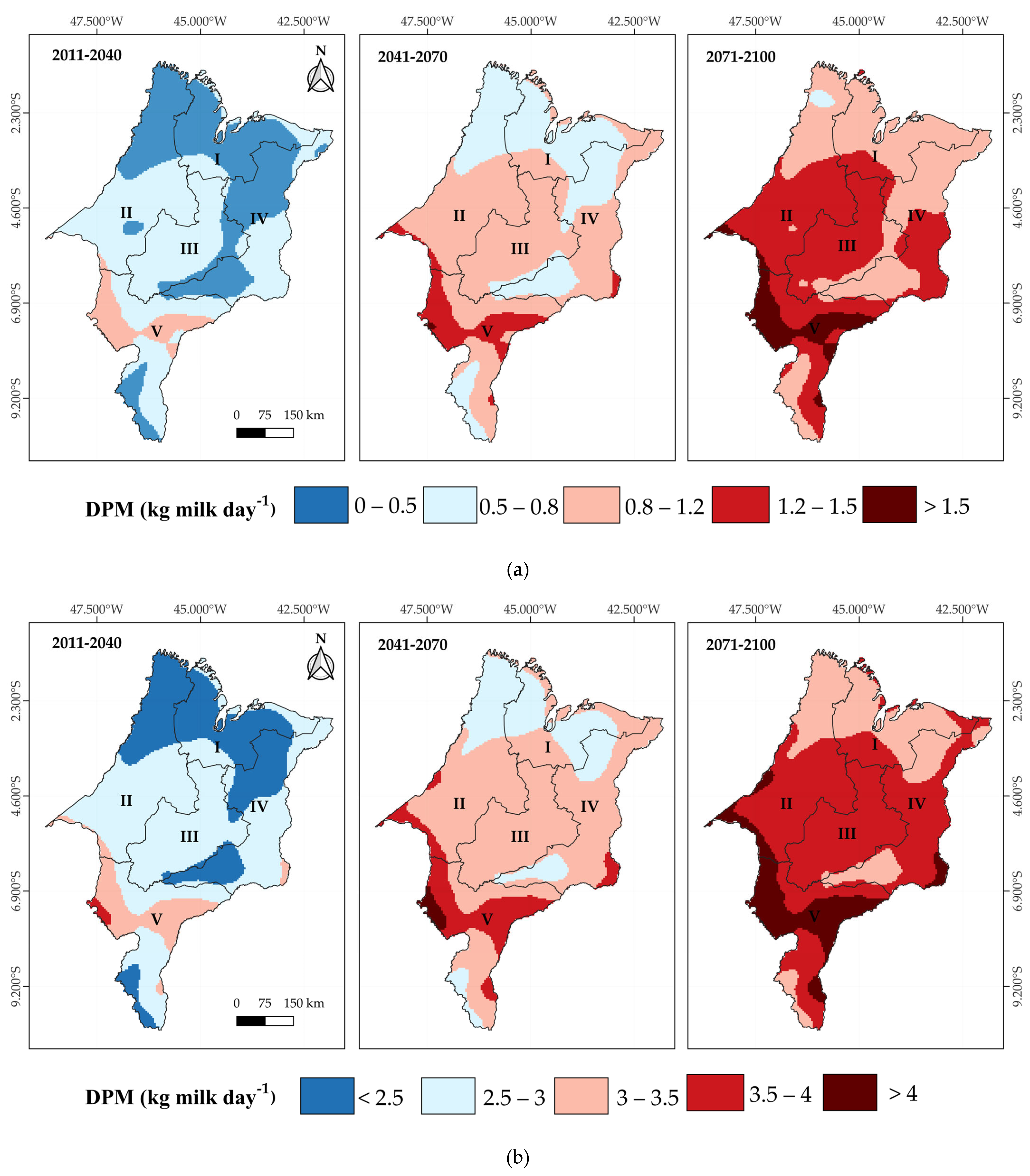

| Item | Onset of the Stress Level | References | ||
|---|---|---|---|---|
| Moderate | High | Extreme | ||
| General cattle | 72 | 78 | 90 | Fuquay [42] |
| Cattle dairy | 72 | 79 | 89 | Pinto et al. [16] and Rahimi et al. [3] |
| SPI | Classification |
|---|---|
| ≥2.00 | Extremely Wet |
| 1.00 to 1.99 | Very Wet |
| 0.50 to 0.99 | Moderately Wet |
| 0.49 to −0.49 | Near Normal |
| −0.50 to −0.99 | Moderately Dry |
| −1.00 to −1.99 | Very Dry |
| ≤−2.00 | Extremely Dry |
| Year | Mean | Min 1 | Max 2 | SD 3 | CV 4 |
|---|---|---|---|---|---|
| 2012 | 77.811 | 72.457 | 81.375 | 1.791 | 2.302 |
| 2013 | 78.030 | 72.934 | 81.346 | 1.642 | 2.104 |
| 2014 | 77.599 | 72.692 | 81.029 | 1.475 | 1.901 |
| 2015 | 78.263 | 73.393 | 81.425 | 1.307 | 1.670 |
| 2016 | 78.584 | 73.778 | 81.817 | 1.579 | 2.009 |
| 2017 | 78.178 | 72.885 | 81.549 | 1.536 | 1.965 |
| 2018 | 77.612 | 72.638 | 80.753 | 1.345 | 1.733 |
| 2019 | 78.373 | 73.690 | 81.229 | 1.172 | 1.495 |
| 2020 | 77.591 | 72.579 | 80.435 | 1.240 | 1.598 |
| 2021 | 77.265 | 72.179 | 89.099 | 1.273 | 1.648 |
| 2022 | 77.117 | 71.980 | 79.748 | 1.131 | 1.467 |
| 2023 | 77.791 | 73.088 | 80.809 | 1.204 | 1.548 |
| Spherical | |||||
| Year | ME 1 | RMSE 2 | MSE 3 | RMSSE 4 | ASE 5 |
| 2012 | −0.000320986 | 0.128319447 | −0.000512021 | 0.800392631 | 0.160438056 |
| 2013 | −0.000315744 | 0.128538646 | −0.000487145 | 0.81826913 | 0.157218868 |
| 2014 | −0.000321951 | 0.128419579 | −0.000554609 | 0.830047674 | 0.154838422 |
| 2015 | −0.000338638 | 0.128918717 | −0.000686003 | 0.846295409 | 0.152458347 |
| 2016 | −0.000309894 | 0.128365609 | −0.000448229 | 0.821033577 | 0.156453329 |
| 2017 | −0.000304233 | 0.128152743 | −0.000454579 | 0.828461322 | 0.154829967 |
| 2018 | −0.000202561 | 0.130590697 | 0.000138732 | 0.791902598 | 0.164944244 |
| 2019 | −0.000162532 | 0.133705573 | 0.000323739 | 0.767968754 | 0.17411815 |
| 2020 | −0.000130996 | 0.133960782 | 0.000503925 | 0.771984532 | 0.173539787 |
| 2021 | −0.000141931 | 0.133116484 | 0.000487361 | 0.76332796 | 0.174411679 |
| 2022 | −1.051 × 10−4 | 0.133694996 | 0.000651064 | 0.748842232 | 0.178522544 |
| 2023 | −0.000238688 | 0.130228631 | −3.58 × 10−5 | 0.805170026 | 0.161808438 |
| Gaussian | |||||
| Year | ME | RMSE | MSE | RMSSE | ASE |
| 2012 | 0.001626452 | 0.182013053 | 0.00779711 | 0.802128 | 0.226911639 |
| 2013 | 0.001406824 | 0.185973639 | 0.00646772 | 0.778031648 | 0.23899667 |
| 2014 | 0.001205019 | 0.187393487 | 0.005395297 | 0.754600831 | 0.248276242 |
| 2015 | 0.001114403 | 0.190652883 | 0.004834541 | 0.7420926 | 0.2568169 |
| 2016 | 0.001339842 | 0.186079898 | 0.006101088 | 0.765508237 | 0.24303419 |
| 2017 | 0.00111343 | 0.189309448 | 0.004984191 | 0.75911917 | 0.2493122 |
| 2018 | 0.000599605 | 0.191581318 | 0.002662496 | 0.70881721 | 0.270140782 |
| 2019 | 0.000869422 | 0.181607237 | 0.003934458 | 0.705810768 | 0.257203767 |
| 2020 | 0.000660389 | 0.192203203 | 0.002877935 | 0.7045586 | 0.27267361 |
| 2021 | 0.001002446 | 0.189840465 | 0.00433775 | 0.721433355 | 0.263044782 |
| 2022 | 0.000106874 | 0.193464814 | 0.000758881 | 0.657260615 | 0.294165691 |
| 2023 | 0.001654166 | 0.179921759 | 0.007887942 | 0.78423291 | 0.229410673 |
| Exponential | |||||
| Year | ME | RMSE | MSE | RMSSE | ASE |
| 2012 | −0.000472255 | 0.12889224 | −0.000958666 | 0.582564257 | 0.221274032 |
| 2013 | −0.000490464 | 0.129299708 | −0.001043384 | 0.594798666 | 0.217402355 |
| 2014 | −0.000490748 | 0.128962683 | −0.001096212 | 0.610484416 | 0.21128051 |
| 2015 | −0.000499266 | 0.129465871 | −0.001163473 | 0.616646626 | 0.209993647 |
| 2016 | −0.000458259 | 0.128978477 | −0.000921173 | 0.602824793 | 0.213965415 |
| 2017 | −0.000467414 | 0.128788414 | −0.000981837 | 0.602542766 | 0.213797067 |
| 2018 | −0.000458935 | 0.128393832 | −0.00097723 | 0.624536891 | 0.20560194 |
| 2019 | −0.000527456 | 0.12990522 | −0.001237933 | 0.605038327 | 0.214717179 |
| 2020 | −0.000469978 | 0.129369522 | −0.00104148 | 0.641470262 | 0.201734207 |
| 2021 | −0.000506541 | 0.129350044 | −0.001099826 | 0.608753309 | 0.212502554 |
| 2022 | −0.00047885 | 0.128458003 | −0.001030727 | 0.625094344 | 0.205531904 |
| 2023 | −0.000471804 | 0.129069315 | −0.000974172 | 0.608991685 | 0.211972383 |
| Year | Model | Nugget Effect | Sill | Range | 1 DSD |
| 2012 | Spherical | 0.00001 | 0.3991 | 7000 | 0.002 |
| 2013 | Spherical | 0.00001 | 0.3284 | 6000 | 0.003 |
| 2014 | Spherical | 0.000196 | 0.2993 | 5700 | 0.065 |
| 2015 | Spherical | 0.00001 | 0.4120 | 8000 | 0.002 |
| 2016 | Spherical | 0.00001 | 0.2980 | 5500 | 0.003 |
| 2017 | Spherical | 0.00001 | 0.3503 | 6600 | 0.002 |
| 2018 | Spherical | 0.004348 | 0.3363 | 7000 | 1.292 |
| 2019 | Spherical | 0.007121 | 0.4263 | 9000 | 1.670 |
| 2020 | Spherical | 0.007842 | 0.3599 | 8000 | 2.178 |
| 2021 | Spherical | 0.007233 | 0.3546 | 7500 | 2.039 |
| 2022 | Spherical | 0.009122 | 0.3087 | 6800 | 2.954 |
| 2023 | Spherical | 0.002712 | 0.4027 | 8000 | 0.673 |
Disclaimer/Publisher’s Note: The statements, opinions and data contained in all publications are solely those of the individual author(s) and contributor(s) and not of MDPI and/or the editor(s). MDPI and/or the editor(s) disclaim responsibility for any injury to people or property resulting from any ideas, methods, instructions or products referred to in the content. |
© 2025 by the authors. Licensee MDPI, Basel, Switzerland. This article is an open access article distributed under the terms and conditions of the Creative Commons Attribution (CC BY) license (https://creativecommons.org/licenses/by/4.0/).
Share and Cite
Sousa, A.C.d.; Sousa, A.M.d.; Corrêa, W.C.; Marques, J.I.; Meneses, K.C.d.; Pandorfi, H.; Silva, T.G.F.d.; Silva, J.L.B.d.; Silva, M.V.d.; Machado, N.A.F. Bioclimatic Zoning and Climate Change Impacts on Dairy Cattle in Maranhão, Brazil. Animals 2025, 15, 1646. https://doi.org/10.3390/ani15111646
Sousa ACd, Sousa AMd, Corrêa WC, Marques JI, Meneses KCd, Pandorfi H, Silva TGFd, Silva JLBd, Silva MVd, Machado NAF. Bioclimatic Zoning and Climate Change Impacts on Dairy Cattle in Maranhão, Brazil. Animals. 2025; 15(11):1646. https://doi.org/10.3390/ani15111646
Chicago/Turabian StyleSousa, Andressa Carvalho de, Andreza Maciel de Sousa, Wellington Cruz Corrêa, Jordânio Inácio Marques, Kamila Cunha de Meneses, Héliton Pandorfi, Thieres George Freire da Silva, Jhon Lennon Bezerra da Silva, Marcos Vinícius da Silva, and Nítalo André Farias Machado. 2025. "Bioclimatic Zoning and Climate Change Impacts on Dairy Cattle in Maranhão, Brazil" Animals 15, no. 11: 1646. https://doi.org/10.3390/ani15111646
APA StyleSousa, A. C. d., Sousa, A. M. d., Corrêa, W. C., Marques, J. I., Meneses, K. C. d., Pandorfi, H., Silva, T. G. F. d., Silva, J. L. B. d., Silva, M. V. d., & Machado, N. A. F. (2025). Bioclimatic Zoning and Climate Change Impacts on Dairy Cattle in Maranhão, Brazil. Animals, 15(11), 1646. https://doi.org/10.3390/ani15111646










